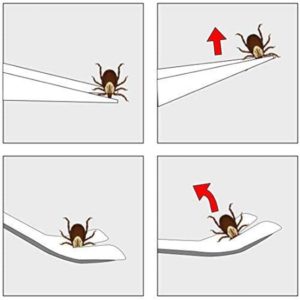You just found a white tick in your cat's ear and you ask if the ticks in cats are transmissible to humans?
Before we explain how to get rid of ticks on your cat, we will discuss the diseases that can be transmitted to your cat by a white tick and those that can be transmitted to men. Thus, we will see that the best way to avoid these diseases is prevention! So, I will tell you the best natural but effective anti-ticks to protect your cat and at the same time protect you too.
White cat tick - What kind of tick?
First of all, you should know that there is not a single species of tick but about 900 species that are present all over the world.
Without going into all tick species, we will only talk about most common ticks in our countryside : Sheep tick (Ixodes ricinus).
When we talk about ticks on a cat, we try to characterize it by its color (white tick ou brown tick) but it is often the same species. Indeed, the color of a tick varies according to its age and the level of blood on which it has engorged.

Cat tick transmissible to humans?
YES : The tick of a cat can very well jump and cling to the skin of a man and thus transmit pathogens to him which will develop diseases, some of which can be serious.
White tick in cats - Transmission of diseases?
All tick species whether white, brown, black, hard or soft, are disease carriers.
In fact, it is not the tick by itself that causes the disease but it can transmit an infection, bacteria or other parasites with which it is infected. For this, it will suck the blood on the skin where it has clung for 24 to 48 hours and transmit a pathogen that will cause the disease.
Ticks are feared because, today we know very well that they are responsible in men for serious illnesses like, among others, encephalitis and Lyme disease. As for the cat, even if the tick will affect its health, the diseases transmitted are less frequent than for humans or for other animals. Let's see that in more detail below.
White tick - Diseases transmissible to cats?
Many diseases can be triggered by the bite of a tick on a cat. However, they are less serious for cats than for men or dogs. Here are the main diseases that a tick can transmit to your cat.
Tick-borne disease - Lyme disease in cats
Lyme disease (or borreliosis) caused by the Borrelia bacteria has many symptoms: fever, joint and muscle pain, severe fatigue, kidney failure, skin problems, etc. If it can be more serious for other animals and especially for in dogs, Lyme disease is easily treated in cats with a simple antibiotic treatment. But the problem is that it is difficult to detect.
Tick-borne disease -Ehrlichiosis in cats
This disease is more common in canines than in felines. However, if your cat suffers from it, this disease (infection of the blood with bacteria) can become chronic if it sets in over time and sometimes fatal. Its symptoms are multiple: strong feverweariness loss of appetite, tired, vomiting.
Tick-borne disease - Hemobartonellosis in cats
Another blood disease that ticks can transmit to your cat isfeline hemobartonellosis. Its symptoms are somewhat the same as for Ehrlichiosis: fever, fatigue, emaciation, mucous membranes more yellow than usual. It is important to correctly diagnose the pathology because, if it is not treated, this disease can be fatal for a cat.
Tick-borne disease - Piroplasmosis in cats
A cat cannot get piroplasmosis from the bite of a tick. In fact, it is when the cat swallows a tick that it can get this disease (destruction of its red blood cells). Anemic, cats can have kidney failure problems or liver problems. Although it is rare, a cat can die from it.
White tick - Diseases transmissible to humans?

Tick-borne disease - Lyme disease in men
Infectious vector disease, Lyme disease is transmitted to humans through the bite of a tick, whether it comes from your cat, your dog or directly from nature. This infection can start within 30 days of the bite.
To begin with, we see one or more red patches that extend in a circle around the area where the tick was. Then often, we feel muscle and joint pain, feel very tired and sometimes we can have a fever.
If diagnosed early enough, this disease is quite easily cured. However, if left untreated, the disease can worsen and become chronic. Over time, it can affect the joints, the brain, the heart ...
Other diseases transmissible by ticks from cats to humans
After Lyme disease, ticks can transmit other pathologies to humans, including:
- Tick-borne encephalitis (a disease that attacks the nervous system and can cause serious damage to the brain);
- Human granulocytic anaplasmosis (a viral infection whose symptoms resemble those of the flu);
- Tularemia (disease caused by bacteria, very rare but treated with antibiotics);
- Q fever, which manifests as a flu-like condition but which can progress and become chronic;
- La TIBOLA (tick-borne lymphadenopathy) and LAR (lymphangitis-associated rickettsiosis).
White tick on cat's ear - How to get rid of it?
To get rid of the tick in your cat's ear or elsewhere on its body, whatever the method, the most important thing will be to remove the entire tick at once: Body, head and rostrum (the oral appliance) .
There are many ways to remove the tick from your cat's skin (see How do I remove a tick from my cat without clamp?):
- With a tick remover : You hang the tick with it and when the tick is stuck in the tick puller, you turn several times then you pull at once. The tick then detaches completely from your cat's skin.

- With tweezers : You wedge the tick with the forceps as close as possible to your cat's skin and you pull, taking care to remove everything.
- With tick repellent : You will pass a spray on the infected area and after a few minutes, the tick detaches itself and falls off.
Once removed or fallen, you must remember to finish killing the tick and get rid of it. And finally, it will be necessary disinfect the area that was bitten by the tick.
White tick in cats - Prevention
The first prevention is to examine your cat's skin regularly and systematically during periods when the cat is outside. So, as soon as you detect the presence of a tick, you can act quickly and avoid infections ...
But in addition, I recommend that you choose among the following preventive treatments:
Natural tick repellent for cats
For those who are looking primarily for a natural anti-tick product to use in prevention in your home and on your cat, baking soda is recommended.
You have been warned! : There are several types of baking soda. Note that for your cat, you will need to use baking soda which is natural and safe for your cat!

How to treat a cat with baking soda against ticks?
In fact, to prevent your cat from catching ticks, it will need to be treated regularly for it to be effective in the long term:
- Brush your cat once a week (minimum) while checking that there are no ticks on its skin;
- Once a month, treat your cat with baking soda as described below:
- Sprinkle baking soda on your cat's coat,
- rub vigorously so that the powder spreads over all areas of his body,
- leave on for 10 minutes so that the baking soda has time to act,
- brush and comb the cat to remove all of the powder.
Know that with baking soda, you will be able to get rid of cat fleas naturally. See my detailed article on the virtues of baking soda for prevention and treatment against cat fleas.
Anti-tick treatment for cats
To avoid all risks to your cat's health and to yours and that of your children, prevention is better than cure!
You can use a tick collar or put a tick repellent on your cat's skin in the form of pipettes. Here are two recommended products:
Does your cat have a fever or seem to be in pain?
Can you give aspirin to a cat?


Ping: How to remove a tick from a cat without clamp?